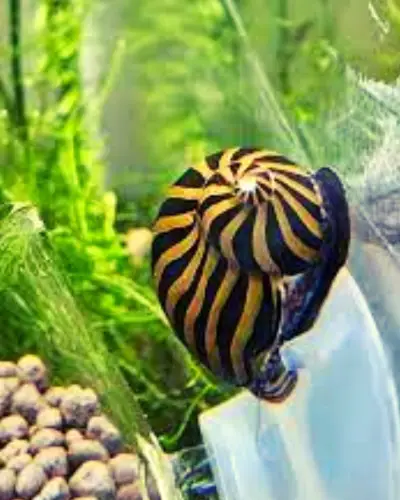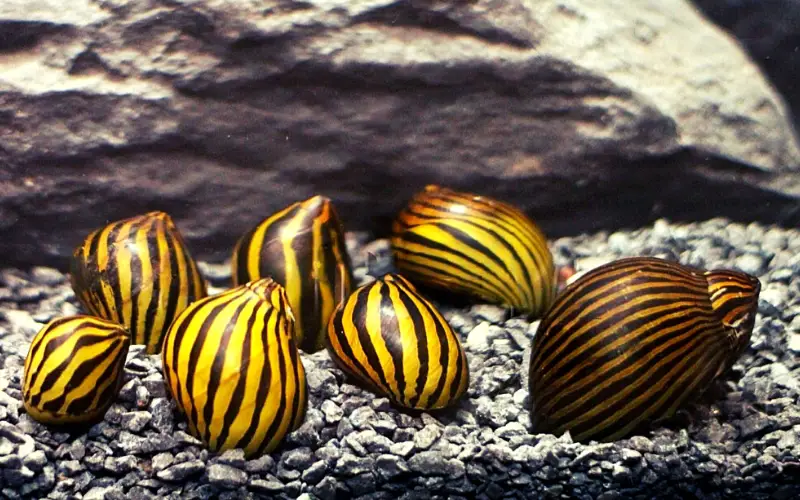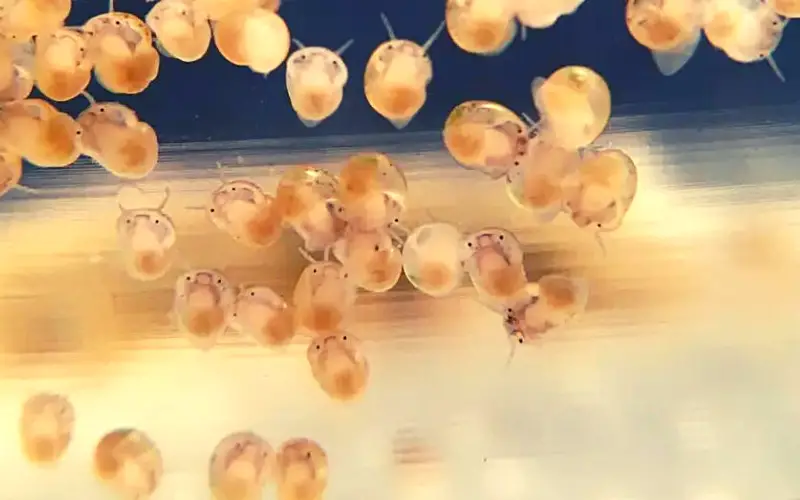Nerite snails breeding can be a rewarding and educational experience for those looking to expand their knowledge of aquatic life. Nerite snails are popular aquarium inhabitants known for their algae-eating abilities and striking shell patterns.
While many aquarium enthusiasts are content with simply enjoying their beauty and cleaning skills, some may be interested in breeding these fascinating creatures.
Breeding nerite snails freshwater can be a bit tricky compared to other species, but it is achievable with the right knowledge and setup.
Understanding their specific breeding behaviors, optimal water conditions, and diet requirements is crucial for success.

Additionally, providing the right environment and ensuring proper care for the eggs and hatchlings is essential for a successful breeding program.
In this article, we will explore the ins and outs of nerite snail breeding, providing valuable information and tips for those interested in embarking on this journey. From setting up a breeding tank to caring for the snails and their offspring, we will cover everything you need to know about breeding these fascinating creatures.
Table of Contents
ToggleWhy do we fail breeding Nerite Snails?
Breeding Nerite Snails can be challenging for a few reasons. One of the main difficulties is that these snails require brackish water to reproduce successfully. This means that the water in the tank needs to have a specific salt content, which can be difficult to maintain consistently.

Nerite Snails also need a nutrient-rich environment to lay their eggs, which can be tricky to achieve in a home aquarium. Another factor contributing to the challenge of breeding Nerites is their complex reproductive cycle.
These snails have a larval stage that requires a specific diet and care, which can be difficult for the average aquarist to provide. As a result, many hobbyists and breeders find it challenging to reproduce Nerite Snails in captivity successfully, and it often requires a significant amount of time, effort, and expertise to do so.
The Mating Process of Nerite Snails
Nerite snails are known for their unique mating process, which starts with the male snail pursuing the female, sometimes for a few hours. Once he catches up to her, the male will nudge and nuzzle the female, signaling his interest in mating.
If the female is receptive, she will release pheromones to signal her readiness. Once the male detects these pheromones, he will align his reproductive organs with the female’s and deposit his sperm into her body. The female will then store the sperm for later use, fertilizing her eggs as needed.
This process allows the female to lay multiple batches of eggs throughout her lifetime without immediate fertilization.
After mating, the female will seek a suitable location to lay her eggs, often on hard surfaces or plants in the aquarium. This fascinating mating process has contributed to the popularity of nerite snails in the aquarium hobby.
Setting Up a Nerite Snails Breeding Tank
Setting up a nerite snails reproduction tank requires careful consideration of several factors to ensure the optimal conditions for successful breeding. Here’s a step-by-step guide to help you set up your black racer nerite snail breeding tank:
- Select the tank: Choose an appropriate tank size for your nerite snails. A 10-gallon tank or larger should be sufficient for breeding a small population of snails.
- Set up filtration: Install a gentle filter in the tank to maintain water quality. Nerite snails prefer slow-moving or still water, so choose a filter with an adjustable flow rate or add a sponge pre-filter to reduce water currents.
- Add substrate: Use a fine-grained substrate like sand or smooth gravel. Nerite snails will often burrow in the substrate, so avoid sharp edges that may harm them.
- Provide hiding spots: Introduce various hiding spots in the tank, such as driftwood, rocks, or caves. These will serve as shelter for the snails and promote breeding behavior.
- Maintain water parameters: Nerite snails thrive in stable water conditions. Keep the water temperature between 72-78°F (22-26°C) and maintain a pH level around 7.5-8.5. Regular water changes are crucial to maintain water quality.
- Introduce compatible tankmates: Nerite snails are peaceful creatures, but choosing tankmates that won’t harm or stress them is important. Avoid aggressive or predatory fish species and opt for peaceful community fish like small tetras or rasboras.
- Provide a varied diet: Nerite snails are primarily algae eaters. Ensure your tank has a good supply of algae, either naturally grown or through algae wafers or tablets. Supplement their diet with blanched vegetables, such as zucchini or spinach, to provide additional nutrients.
- Monitor breeding conditions: Nerite snails require brackish water conditions for their eggs to hatch successfully. To simulate this, you can introduce marine salt mix or marine saltwater in a separate container and use a small airline tube to drip the salty water into the breeding tank slowly. Maintain a salinity level of around 1.005-1.010 specific gravity.
- Observe breeding behavior: Once the breeding tank is set up, closely monitor the snails for signs of mating behavior. Nerite snails typically lay gelatinous egg capsules on hard surfaces above the waterline, such as tank walls, decorations, or filter outlets. If you notice any eggs, avoid removing them, as they require brackish water to hatch.
- Raise the hatchlings: When the snail eggs hatch, the larvae enter the water and must be raised in a separate rearing tank with salty water. Feed them with microalgae or powdered spirulina until they grow large enough to handle regular freshwater conditions. The larvae will eventually transform into juvenile snails.
Remember, breeding nerite snails can be challenging, and successful reproduction is not always guaranteed. Patience and careful attention to water parameters and breeding conditions are key to increasing your tank’s likelihood of successful breeding.
How to Breed Nerite Snails: A Simple Nerite Snails Breeding Guide for Aquarists
The process of breeding Nerite snails is relatively simple, but there are a few key factors to consider. Firstly, providing the snails with a healthy environment that mimics their natural habitat is important.
This includes maintaining stable water conditions, providing plenty of algae for them to feed on, and ensuring adequate calcium rich substrate for shell growth. It’s also crucial to have a balanced male-to-female ratio in the tank to encourage breeding.
Once the snails have mated, the female will lay eggs on hard surfaces in the aquarium. However, it’s important to note that Nerite snails require brackish water to hatch their eggs successfully, so aquarists may need to transfer the eggs to a separate brackish tank for hatching.
Aquarists can successfully breed Nerite snails and enjoy watching the next generation thrive in their aquarium with proper care and attention to their breeding needs.
Will Different Types of Nerite Snails Breed?
No, different types of nerite snails will not breed with each other. Each species of nerite snail has unique reproductive organs and behaviors, and they are incompatible with other species. For successful breeding, you must keep nerite snails of the same species together.
Here are some of the different types of nerite snails that are popular in the aquarium hobby:
- Zebra Nerite Snail (Neritina natalensis): This is the most common type of nerite snail. They are black and white striped and very effective at eating algae.
- Tiger Nerite Snail (Neritina turrita): This snail is dark amber with small black markings. They are also good algae eaters.
- Olive Nerite Snail (Neritina reclivata): This snail is olive green. They are not as common as zebra or tiger nerites but are still good algae eaters.
- Horned Nerite Snail (Neritina Clithon corona): This snail has a small horn on its shell. They are not as effective at eating algae as other nerite snails but are still popular in aquariums.
- Black Racer Nerite Snail (Neritina pulligera): This black snail has a yellow stripe down its shell. They are not as common as other nerite snails but are still good algae eaters.
If you are interested in breeding nerite snails, it is important to do your research to ensure that you are keeping the right species together. You must also provide them with the right water conditions and food.
Preparing Larvae Rearing Tank for Nerite Snails
Preparing a larvae-rearing tank for nerite snails requires careful consideration of water quality, temperature, and food availability. Start by setting up a suitable tank with a capacity of at least 10 gallons, and ensure it is equipped with a filtration system to maintain water quality.
The water temperature should be kept between 75-78°F, as this is the ideal range for nerite snail larvae. Additionally, it is important to provide appropriate food sources, such as phytoplankton and algae, for the larvae to feed on.
You can also introduce live cultures of microorganisms like rotifers and copepods to ensure a diverse and nutritious diet for the developing snails. Maintaining a clean and stable environment in the fish tank is crucial to promote healthy growth and development of the snail larvae.
Growing and Caring for Baby Nerite Snails in Aquarium
Unfortunately, breeding and raising baby Nerite Snails in an aquarium is challenging and not recommended for beginners. These snails spend their larval stage in brackish water, requiring a separate tank setup and specific care. Additionally, they can only reproduce in fresh water once they reach adulthood, rendering the effort somewhat pointless if you have a brackish water setup.
However, if you’re still interested in learning about the process, here’s a brief overview:
Setting up a Larval Tank:
- Tank size: A small tank, around 1-5 gallons, is sufficient.
- Water: Prepare brackish water with a salinity of 5-10 ppt (parts per thousand). You can achieve this by mixing marine salt with RO/DI water or pre-mixed brackish water solution.
- Temperature: Maintain between 65 to 85 degrees Fahrenheit (26-30°C) to accelerate larval growth.
- Filtration: Use minimal or no mechanical filtration, as it can suck up the tiny larvae. An air bubble line set at a low flow rate is recommended for aeration.
- Lighting: Keep the lights on 24/7 to promote algae growth, which serves as the young snails’ food source.
Caring for Larvae:
- Feeding: Infusoria, green water, golden pearls, powdered fry food, and spirulina powder are suitable food options for the larvae.
- Water changes: Perform regular small water changes (10-20%) to maintain water quality and prevent ammonia buildup.
- Monitoring: Closely monitor the larvae for any signs of distress or mortality. Adjust water parameters or feeding routines as needed.
Transitioning to Freshwater:
- Once the larvae develop shells and become tiny snails, gradually acclimate them to freshwater over 1-2 months.
- Slowly replace small amounts of brackish water with mineral-rich fresh water.
- Ensure the freshwater parameters (pH, hardness, temperature) are compatible with adult Nerite snails.
Feeding larvae Nerite snail larvae (veligers)
Feeding These tiny larvae require specific nutrients to support their growth and development. One common and effective food source for Nerite snail veligers is microalgae. This can be purchased in a liquid or powdered form and added to the larvae’s tank.
Commercial larval snail food is also available and can provide the necessary nutrients for their development. It’s important to monitor the feeding process closely and ensure that the larvae consume adequate food.

Overfeeding can lead to water contamination and adverse effects on the larval snails, so following recommended feeding guidelines is crucial.
A well-balanced diet for Nerite snail larvae is essential for their healthy development into adult snails. With proper care and attention to their feeding needs, Nerite snail veligers can grow into thriving adult snails.
Commonly Asked Questions about Nerite Snails Reproduction(FAQs)
Will Nerite snail eggs hatch in freshwater?
Unfortunately, The Nerite eggs cannot breed in freshwater tanks. They require saltwater to hatch. So, while you might see the eggs, they won’t become baby nerites in your freshwater setup.
Why are my Nerite snails on top of each other?
Nerite snails stack to establish stability, mate, or access food. Stacking provides a secure position, facilitates reproduction, and allows easier access to algae and biofilm, their primary food sources.
Will Nerite snails breed in saltwater tanks?
Nerite snails rarely breed in full saltwater. They require brackish water (1.005-1.010) for successful egg hatching. While eggs might appear, freshwater is needed for the fry to survive.
What are the benefits of keeping nerite snails in a freshwater aquarium?
Nerite snails offer triple the benefit! Algae control, detritus cleanup, and peaceful cohabitation. Perfect low-maintenance addition to your freshwater tank!
How do the nerite snail eggs hatch?
Nerite snail eggs hatch when submerged in water, usually within 2-5 weeks. The larvae develop inside the eggs until they are ready to hatch, releasing miniature snails into the water.
Do nerites clean algae better than apple snails or other snails do?
Nerite snails are efficient algae eaters known for their excellent cleaning abilities. Nerites are considered more effective in consuming and controlling algae growth than apple snails and many other snail species.
What are the best tank mates for nerite snails?
Peaceful pals for Nerite snails: Rasboras, tetras, shrimp, catfish. Avoid snail-eaters like puffers, loaches, and aggressive fish! Enjoy your harmonious tank!
Do male and female Nerite snails lay eggs?
Surprise! Only female Nerite snails lay eggs. Males fertilize them, but neither survive in freshwater. Neat, huh? So enjoy the algae control, not the babies!
Do Nerite snails reproduce asexually?
Nope, Nerite snails are the party of two! They reproduce sexually, with females laying eggs needing male fertilization. But freshwater fun ends there – babies require saltwater for hatching.
Why can’t Nerite snails reproduce in freshwater?
Nerite hatchlings need a salty start! Their larvae can’t survive freshwater, needing brackish water to develop. So, while eggs may appear, they won’t become baby snails in your freshwater tank.
Do Nerite snails cross-breed?
No Nerite crossbreeding drama! Different Nerite types likely stick to their kind. Their complex life cycle (brackish water larvae) makes accidental mixing improbable. Relax, your tank won’t turn into a hybrid haven!
Can I put crushed coral in my aquarium?
Crushed coral can raise your tank’s pH, but use it cautiously! It’s ideal for hard water and alkaline-loving fish but can harm others. Test your water and research fish needs first!
Conclusion
In conclusion, breeding Nerite snails can be a challenging but rewarding endeavor for aquarium enthusiasts. While it is difficult to breed them in a home aquarium setting due to their specific environmental and dietary needs, it is not impossible. Those willing to put in the time and effort to create the ideal conditions may successfully raise Nerite snail offspring. However, it is important to note that breeding Nerite snails can be unpredictable and inconsistent even under the best circumstances.
Factors such as water quality, temperature, and the genetic predisposition of the snails all play a role in successful breeding. While Nerite snails breeding may be more complex than with other aquarium creatures, it can be a valuable learning experience for hobbyists and a source of fascination and wonder as they observe the intriguing behaviors of these unique snails in their tank.
You might also like
- Do Nerite Snails Reproduce: (Tips for Successful Breeding)
- Nerite Snail Poop: 3 Powerful Tips to Eliminate Snail Waste
- Nerite Snail Lifespan 101: Longevity Secrets & Care Tips
- Different Types of Nerite Snails: (Your Aquatic Companion)
- Nerite Snail Babies Care 101: A Comprehensive Beginner Guide
- Nerite Snails Size 101: (Expert Care Guide & Tank Set Up)
- How Do Nerite Snails Mate: (The Ultimate Guide)
- How Often Does Nerite Snail Lay Eggs: (A Comprehensive Guide)
- Will Nerite Snail Eggs Hatch in Freshwater Tank (Shocking Truth!)
- Nerite Snail Water Parameters: (Experts Care & Tank Set Up)
- Black Racer Snail: A Comprehensive Beginners Guide




